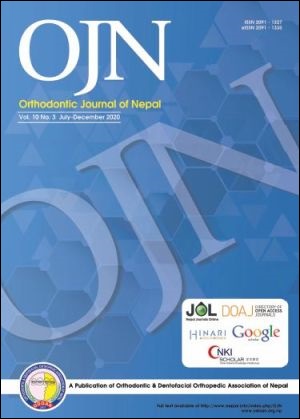Assessment of role of mandibular third molar in lower anterior crowding among orthodontic patients of Kathmandu Nepal
DOI:
https://doi.org/10.3126/ojn.v10i3.35486Keywords:
Agenesis, Lower anterior crowding, Mandibular third molarsAbstract
Introduction: Crowding in mandibular arch increases with increasing age and etiology of crowding is multifactorial in nature. Role of mandibular third molar in lower anterior crowding remains a topic of controvery over a period of century. The objective of this study was to assess whether there is any correlation between presence of mandibular third molar position and lower anterior crowding.
Materials and Method: On the basis of third molar position one hundred and six sample of pretreatment orthodontic patients aged between 17 to 38 years were divided into erupted, erupting and agenesis group. The study was conducted in Peoples Dental College and Hospital from January 2020 to March 2020 after obtaining ethical approval from the institutional review committee. This cross-sectional study was done on dental casts and orthopantomogram; brass wire was used for measuring arch length and digital vernier caliper for measuring tooth material with modified segmental arch analysis method.
Result: Among 106 samples collected 55 (51.88%) were female and 51(48.11%) were male and the mean age was 21.53 ± 3.91 years, Chi square and ANOVA test was used for Statistical analysis. This study showed no statistically significant differences between third molar position and lower anterior crowding on right (P= 0.68) and left side (P = 0.45). The study also showed that association between the third molar position and lower anterior crowding is more on left side compared to right side.
Conclusion: Mandibular third molars have not statistically significant difference in lower anterior crowding so, extraction of third molars for relieving the anterior crowding is not justifiable
Downloads
Downloads
Published
How to Cite
Issue
Section
License
Copyright © held by Orthodontic & Dentofacial Orthopedic Association of Nepal
- Copyright on any research article is transferred in full to the Orthodontic & Dentofacial Orthopedic Association of Nepal upon publication in the journal. The copyright transfer includes the right to reproduce and distribute the article in any form of reproduction (printing, electronic media or any other form).
- Articles in the Orthodontic Journal of Nepal are Open Access articles published under the Creative Commons CC BY License (https://creativecommons.org/licenses/by/4.0/)
- This license permits use, distribution and reproduction in any medium, provided the original work is properly cited.




